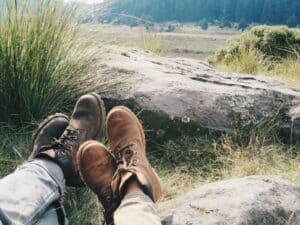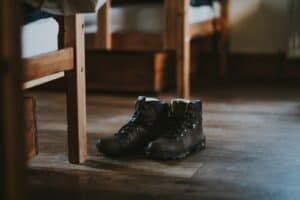When it comes to hiking, I’ve learned that the right pair of boots can make or break your adventure. I’ll be sharing some practical hiking boots tips to ensure you’re well-equipped for your next outdoor escapade.
Choosing the perfect pair isn’t about picking the most expensive or the most stylish, it’s about understanding your needs and knowing what to look for. In this article, I’ll guide you through the process, from understanding the different types of hiking boots to making sure they fit just right.
Understanding the Different Types of Hiking Boots

You might think a boot is a boot, but that’s far from the truth. In the world of hiking, different boots cater to diverse needs and terrains, and understanding these differences is crucial to a successful hike.
Firstly, let’s talk about light hiking shoes: a step above your casual walking shoes. These type of boots are best for day hiking as they’re generally more breathable and lightweight. That makes your hiking experience feel less labor-intensive and more of a leisurely walk, just with amazing views.
Moving up in durability, we have mid-weight hiking boots. These are all-around champions for hikers who enjoy different trails, as they provide a delicate balance between weight, stability, and durability. They’re built to handle rougher terrains while offering more ankle support and waterproofing. Highly versatile, mid-weight boots are popular choices for multi-day hikes or even brief backpacking excursions.
Lastly, we have mountaineering boots. You won’t need the tank-like durability of these boots for a casual stroll in the park. These are specifically designed for serious hikers heading towards rugged, off-beaten paths. With stiff soles and high and tough ankle support, they’re meant to handle the harsh challenges of heavy backpacking and rock climbing.
Besides these three main types, there are hybrid styles as well. For instance, you might find boots that blend light-weight design with the rugged durability of mountaineering boots. Knowing these differences will be your first step to identifying the perfect pair for your hiking adventure!
With style definitions down, it’s time to talk about another significant aspect: fit. No matter how excellent the boot is, if it doesn’t fit you properly, you’re in for an uncomfortable hike…
Factors to Consider When Choosing Hiking Boots
Now that we’ve walked through the different styles and types of hiking boots, it’s time to delve into the essential factors you should consider when choosing a pair. Your comfort, safety, and hiking experience heavily rely on making a conscious, informed decision.
Fit is undoubtedly the most crucial factor. No matter how well-made or expensive the boots are, if they don’t fit, they’re not for you. Your boots should snugly fit your feet, with a bit of room for your toes to move. Remember to try on boots with the same socks you’ll wear for hiking, with the laces properly tied up just like you would when hiking.
Alongside a good fit, the material of the boots can make or break your hiking experience. Leather offers durability and water resistance but may require a break-in period. Synthetic materials, such as Gore-Tex, are lighter, dry faster, and usually cost less, but may wear out sooner.
Support and stability are paramount to prevent injuries, particularly on mountainous terrains. Look for boots with ankle support – usually mid to high cut styles. The sole should be sturdy and rigid enough not to twist, providing a firm footing even on rough trails.
Next up is traction. The soles should offer a good grip on both wet and dry surfaces to prevent slipping. Vibram soles are known for their excellent traction and durability. Don’t forget to examine the lug pattern – deeper, thicker lugs perform better on muddy or loose terrains, while a tighter pattern suits hard, rocky surfaces better.
Lastly, weight also plays a pivotal role in your decision. A lighter boot will reduce fatigue but may lack in durability and support. Mid-weight boots strike a balance between weight and performance, making them an ideal choice for various terrains.
How to Properly Fit Hiking Boots

Let’s dive into the specifics of fitting your hiking boots for that perfect harmony between comfort and functionality. The ideal fit minimizes blisters, gives essential ankle support and ultimately increases your enjoyment on the trail.
A common mistake I’ve seen among hikers is buying boots that are too small. Always remember, your size for hiking boots is often larger than your ordinary shoe size. That’s because your feet tend to swell after long hours of hiking, especially in the heat.
Where does one start with fitting hiking boots properly?
- Try them in the afternoon or evening: Your feet are at their largest around this time, providing a more accurate fitting.
- Wear your usual hiking socks: It’s not just about fitting the boots, your hiking socks matter too.
- Use the ‘thumb’s width’ rule: There should be enough room to fit your thumb between your longest toe and the end of the boot. This ensures you won’t have sore toes on downhill sections of your hike.
- Check the heel and ankle fit: You don’t want a boot that slips on your heel, as this can lead to blisters. Your ankle should feel secure for stability, yet not overly tight.
If possible, walking up and down stairs or an inclined surface can give you a great idea of how the boots will perform on a hike.
I can’t stress enough how important it’s to invest time in trying on different brands and sizes. Each brand comes with a unique fit and what works for someone else might not work for you. Yes, it might be time-consuming, but believe me, your feet will thank you on those long treks.
Next, let’s turn our attention to the materials used in hiking boots, and why they matter.
Tips for Breaking in Hiking Boots
Once you’ve got those perfect-fit hiking boots, it’s important not to hit the trails right away. Breaking in your hiking boots is a key step and can greatly impact your hiking experience. Here are some tips to ensure a comfortable and seamless break-in process.
Walk Around at Home
To break in your new boots, start by wearing them at home. Stroll around your house for a few hours each day. Sure, it may feel odd cooking dinner or watching TV with hiking boots on, but believe me, your feet will thank you later.
Short Test Hikes
After a few days of indoor usage, take your boots for short local hikes. Start with easy trails before tackling more strenuous terrain. This will allow your boots to adapt gradually to the rigors of hiking.
Gradually Increase Duration
Increase your hiking time slowly. If you start by hiking for an hour, add an extra half hour every other hike. This gives your boots sufficient time to mold to your feet, creating an ideal fit.
Use Thick Socks
While breaking in your boots, always wear the same type of socks you plan to hike with. This highlights any points of friction earlier than when hiking, preventing future discomfort.
Remember, breaking in hiking boots can’t be rushed. Just like a good wine, it takes time. So, allow a couple of weeks before your big trek, and your feet will feel right at home in your new boots.
And now, let’s move onto some interesting facts about the materials used in hiking boots…
Maintenance and Care for Hiking Boots

You’ve spent time carefully picking out your hiking boots, and they’ve been on several adventures with you. It’s crucial to know how to maintain and care for your hiking boots to ensure they stay durable for years to come. A well-cared for boot not only looks good, it’s comfort and protective features are preserved longer.
First off, clean your boots after every hike. Dust, mud, and sweat residue may seem harmless but frequently contribute to the deterioration of your boots. Use a soft brush and warm water to clean off dirt. Avoid using hard brushes or strong detergents as these can damage the outer material and shorten boot lifespan.
Also, don’t forget to withdraw the insoles and let them dry out after each heavy-duty use. The interiors of hiking boots tend to stay damp which can lead to a buildup of bacteria and odors. Opening up your boots and letting them air-dry is an efficient solution to curb this.
Never put your boots near a heat source to speed up drying. This can cause the rubber soles to loosen and the upper material to stiffen. Instead, store them in a well-ventilated spot away from direct sunlight.
Next up is dealing with scuffs and scratches. Use leather conditioner for leather boots, and use a fabric boot sealer for synthetic materials. Sealants help restore the waterproof properties of your boot and are available in different variations based on the type of material used.
Finally, saving perhaps the most important for last, is regularly inspecting your boots for any wear and tear. The sooner you spot an issue, the sooner you can address it. Depending on your usage, an annual or bi-annual inspection is a great practice.
Maintenance and care may seem tedious, but it’s an integral part of owning hiking boots. The water you cross, the mud you slog through, and the miles you trek can take a toll on your boots. Hence, giving them the necessary maintenance helps prolong their life, ensuring they’re always ready for the next adventure.
In the following section, we’ll explore the benefits of periodically replacing worn-out hiking gear, emphasizing the importance of safety and functionality in outdoor activities.
Conclusion: Hiking Boots Tips
I’ve shared my top tips on breaking in and caring for your hiking boots. Remember, it’s about more than just comfort – it’s about safety too. So, don’t skip the break-in process or neglect regular maintenance. Your boots are your best friends on the trail, so treat them right.
And don’t forget, even the best boots won’t last forever. Keep an eye on the wear and tear, and don’t be afraid to replace them when the time comes. After all, your adventures are only as good as your gear. So, here’s to many more hikes in boots that feel just right!
Stay safe, stay comfortable, and most importantly, keep exploring!
Other suggested articles:


